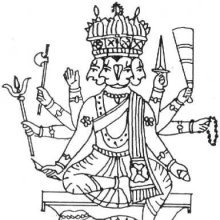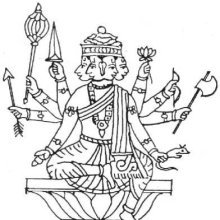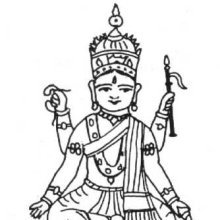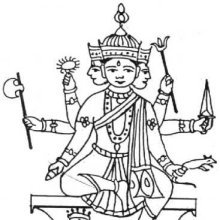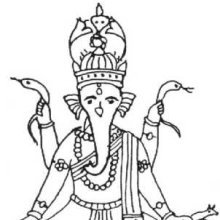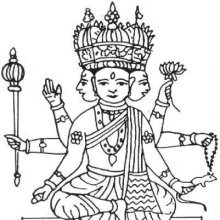Citron: 3 definitions
Introduction:
Citron means something in Hinduism, Sanskrit, Jainism, Prakrit, biology. If you want to know the exact meaning, history, etymology or English translation of this term then check out the descriptions on this page. Add your comment or reference to a book if you want to contribute to this summary article.
Images (photo gallery)
(+17 more images available)
In Hinduism
Shilpashastra (iconography)
Source: Shodhganga: Elements of Art and Architecture in the Trtiyakhanda of the Visnudharmottarapurana (shilpa)The Citron (tree) in iconography is associated with Dhūmorṇā, the wife of Yama, according to the Viṣṇudharmottarapurāṇa, an ancient Sanskrit text which (being encyclopedic in nature) deals with a variety of cultural topics such as arts, architecture, music, grammar and astronomy.—According to the Viṣṇudharmottarapurāṇa, the image of Yama should be made along with his wife Dhūmorṇā. The image of Dhūmorṇā should have two hands having mātuluṅga i.e., a kind of citron tree, in her left hand and her right hand should be placed on the back of her husband. Thus it is clear that the Viṣṇudharmottarapurāṇa offers a great field of knowledge regarding the nuances of Indian art of Image making [e.g., the citron tree] during 10th–11th century A.D.

Shilpashastra (शिल्पशास्त्र, śilpaśāstra) represents the ancient Indian science (shastra) of creative arts (shilpa) such as sculpture, iconography and painting. Closely related to Vastushastra (architecture), they often share the same literature.
In Jainism
General definition (in Jainism)
Source: academia.edu: Tessitori Collection ICitron refers to the fruit which was offered by Revatī to Mahāvīra, according to the Revatīsajjhāya (dealing with the lives of Jain female heroes), which is included in the collection of manuscripts at the ‘Vincenzo Joppi’ library, collected by Luigi Pio Tessitori during his visit to Rajasthan between 1914 and 1919.—Revatī was the lady who offered proper food to Mahāvīra as he was ill after Gosāla’s attack. The earliest account is found in Bhagavatīsūtra XV. The food item was Sanskrit bījapūraka, a kind of citron (here vījorāpāka).

Jainism is an Indian religion of Dharma whose doctrine revolves around harmlessness (ahimsa) towards every living being. The two major branches (Digambara and Svetambara) of Jainism stimulate self-control (or, shramana, ‘self-reliance’) and spiritual development through a path of peace for the soul to progess to the ultimate goal.
Biology (plants and animals)
Source: Google Books: CRC World Dictionary (Regional names)Citron in English is the name of a plant defined with Citrus medica in various botanical sources. This page contains potential references in Ayurveda, modern medicine, and other folk traditions or local practices It has the synonym Sarcodactilis helicteroides Gaertn. (among others).
Example references for further research on medicinal uses or toxicity (see latin names for full list):
· Species Plantarum (1753)
· Flora Indica (1768)
· Reise nach Ostindien und China (1765)
· Fieldiana, Botany (1946)
· Supplementum Carpologiae (1805)
· Plantae Wilsonianae (1914)
If you are looking for specific details regarding Citron, for example pregnancy safety, diet and recipes, extract dosage, side effects, health benefits, chemical composition, have a look at these references.

This sections includes definitions from the five kingdoms of living things: Animals, Plants, Fungi, Protists and Monera. It will include both the official binomial nomenclature (scientific names usually in Latin) as well as regional spellings and variants.
See also (Relevant definitions)
Starts with: Citron juice, Citronella, Citronella mucronata.
Ends with: Medicinal citron.
Full-text (+260): Matulunga, Bijapuraka, Bijapura, Cholanga, Amlakeshara, Jambira, Kesaramla, Vaktrashodhin, Mukhashodhin, Mulakeshara, Vanapuraka, Madhujambira, Matulanga, Mahalunga, Phalapura, Icchaka, Turanja, Atyamla, Jambhin, Vrihaccitta.
Relevant text
Search found 42 books and stories containing Citron; (plurals include: Citrons). You can also click to the full overview containing English textual excerpts. Below are direct links for the most relevant articles:
Trishashti Shalaka Purusha Caritra (by Helen M. Johnson)
Part 10: Nami’s śāsanadevatās (messenger-deities) < [Chapter XI - Śrī Namināthacaritra]
Part 9: Ara’s śāsanadevatās (messenger-deities) < [Chapter II - Śrī Aranāthacaritra]
Part 16: Malli’s śāsanadevatās (messenger-deities) < [Chapter VI - Śrī Mallināthacaritra]
Jain Remains of Ancient Bengal (by Shubha Majumder)
The Skanda Purana (by G. V. Tagare)
Chapter 46 - Abduction of Śacī < [Section 3 - Revā-khaṇḍa]
Chapter 6 - Description of the Land of Utkala < [Section 2 - Puruṣottama-kṣetra-māhātmya]
Chapter 30 - Description of the Hermitage of Bharadvāja < [Section 1 - Veṅkaṭācala-māhātmya]
The Jataka tales [English], Volume 1-6 (by Robert Chalmers)
Jataka 396: Kukku-jātaka < [Volume 3]
Kathasaritsagara (the Ocean of Story) (by Somadeva)
Chapter LIII < [Book IX - Alaṅkāravatī]
Chapter LXIX < [Book XII - Śaśāṅkavatī]
Foreword to volume 9 < [Forewords]
The Indian Buddhist Iconography (by Benoytosh Bhattachacharyya)
Related products
